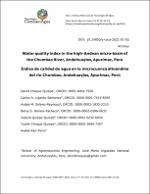Water quality index in the high-andean micro-basin of the Chumbao river, Andahuaylas, Apurímac, Perú

View/
Date
2021Author(s)
Choque Quispe, David
Ligarda Samanez, Carlos A.
Solano Reynoso, Aydeé M.
Ramos Pacheco, Betsy S.
Quispe Quispe, Yadyra
Choque Quispe, Yudith
Kari Ferro, Aydeé
Metadata
Show full item recordAbstract
The water quality index (WQI) of a water body, indicates the degree of
contamination for a given use, and it is related to the anthropic activities
that they provoke around. The objective was to determine the WQI, in
the high-Andean micro-basin of the Chumbao River, Andahuaylas, Peru.
The section of study was included between the head of the basin
(13°46'42.5" S, 73°13'50.0" W and 4 295 m of altitude), and last sampling point (13°35'26.4" S, 73°27'0.8" W and 2 529 m of altitude),
with an average slope of 4%. The WQI Dinius was evaluated considering
parameters such as oxygen level (DO and BOD5), eutrophication level
(NO3
- and PO4
3-), physical characteristics (temperature, turbidity, color
and TDS), dissolved substances (alkalinity, hardness, pH, conductivity
and chlorides), and microbiological parameters (E. coli and total
coliforms); it was sampled during the avenues season (02 lentic points
and 08 lotics). The data were collected in triplicate, and analyzed through
an ANOVA, Tukey test and Pearson's correlation at 5% significance. It was
found that the predominant use of river water is for agriculture, pasture
and urbanization; the WQI is divided into three categories Excellent (M1,
M2, M3, M4 and M5) close to the head of the micro-basin and the lentic
points (Pampahuasi and Paccoccocha lagoons), Acceptable (M6), and
excessively contaminated points M7 and M8 outside the urban area
downstream (p-value < 0.05); presenting a good negative correlation
with the study parameters. In conclusion, the water in areas of low
population density is good.
Collections
The following license files are associated with this item:
